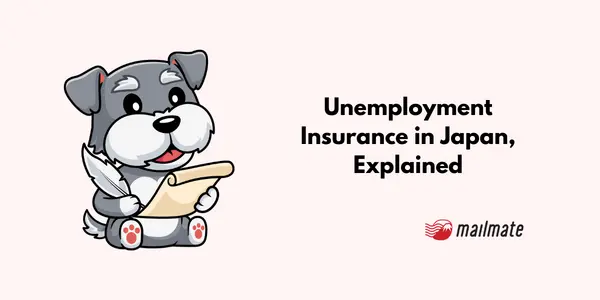Unemployment Insurance in Japan, Explained

Congratulations! You've hired your first full-time employee! What happens next?
For the majority of businesses in Japan, the next step involves enrolling your employees in labor insurance 労働保険 = roudou hoken, of which there are 2 parts: unemployment insurance 雇用保険 = koyou hoken and worker's accident insurance 労災保険 = rousai hoken.
There are also an additional two social insurance programs: employees' health insurance and employees' pension, referred collectively as 社会保険 = “social insurance,” which we covered previously.
In this article, we focus on unemployment insurance in Japan, what to know as a business owner, the benefits, the costs, and the documents to fill out in order to enroll.
An overview of unemployment insurance in Japan
While England was the first to have a full-fledged government-managed unemployment insurance program, enabled by their National Insurance Act established in 1911, many countries adopted similar programs around this time.
In Japan, however, it was not until after WWII in 1947 that their first Unemployment Insurance Act was established, providing the legal framework for a proto-unemployment insurance system.
The government later replaced that law with the current Employment Insurance Act in 1974 to keep in step with rapidly changing social and economic environments.
Today, unemployment insurance covers unemployment benefits, parental leave, caregiving, employment at old age, and employer subsidies such as benefits received for hiring single mothers, senior citizens, and the disabled.
The current government-managed unemployment insurance is paid for by the employer and the employee, with the scales tipped toward employers paying a higher percentage of the monthly premium.
For the majority of businesses in Japan, enrollment in this insurance program is compulsory, and there are penalties associated with non-compliance.
How to determine if your business must cover unemployment insurance
If you have even one employee, you are considered a business establishment that is obliged to pay for unemployment insurance, 雇用保険適用事業所 = koyouhoken tekiyou jigyousho
Are there exceptions? Yes. Private businesses in agriculture, forestry, or fishery with less than five employees are exempt from enrolling in unemployment insurance.
Additionally, unemployment insurance is not applicable to individuals that fall under the following categories:
Regular working hours are under 20 hours per week
Not expected to work longer than 30 days under 1 employer
Seasonal work, contracted to work less than 4 months or where regular working hours are under 30 hours per week
Students*
*Exceptions: Students who are studying remotely or studying during the evening, undergraduates, students who are planning to work at the same establishment after graduation, and students on leave are eligible to enroll in unemployment insurance.
Refer to this Q&A (Japanese) on the Ministry of Health, Labour and Welfare site.
How much will it cost to enroll in unemployment insurance?
Premiums for unemployment insurance follow this calculation: (standard monthly salary or bonus) x insurance premium rate = unemployment insurance premium.
Insurance premium rates differ by the following 3 business types:
*General enterprises 一般の事業 = ippan no jigyou
Employee premium rate 0.003% + employer premium rate 0.006% = total premium rate 0.009%
*Agriculture, Forestry, and Fishery/Sake brewing industry 農林水産・清酒製造の事業 nourinsuisan/seishu seizou no jigyou
Employee premium rate 0.004% + employer premium rate 0.007% = total premium rate 0.011%
*Construction industry 建設の事業 = kensetsu no jigyou
Employee premium rates 0.004% + employer premium rates 0.008% = total premium rate 0.012%
For example, say the monthly salary for employee John Doe is ¥300,000 and the bonus is ¥500,000. The company is a general enterprise, meaning the premium rate for John Doe is 0.003%. So the calculation will look something like this:
¥300,000 (JD's salary) x 0.003% (average enterprise employee premium rate) = ¥900 (JD's premium fee)
¥500,000 (JD's bonus) x 0.003% (average enterprise employee premium rate) = ¥1500 (JD's premium fee)
Numbers 0.5 and under are rounded down. Numbers above 0.6 are rounded up. Here's an example of a John Doe with a different salary:
¥243,088 (JD's salary) x 0.003% (average enterprise employee premium rate) = ¥729.264 → ¥729 (JD's premium fee)
¥243,900 (JD's salary) x 0.003% (average enterprise employee premium rate) = ¥731.7 → ¥732 (JD's premium fee)
Examples above are sourced from this article by freee.co.jp.
Note: This article and the previous articles in this series, “Employees Pension Insurance in Japan,” “Employees Health Insurance in Japan,” "Workers' Accident Insurance in Japan" are intended to provide you with general information only.
Remuneration subject to calculation of fees
Employees' monthly salaries and bonuses are subject to calculation and withdrawal of insurance fees.
When calculating the insurance fee, the salary or bonus amount applied to the formula must be the amount before withdrawing taxes and social insurance fees.
But what about allowances, gifts, compensation, and other forms of remuneration, such as commuting allowances, dependent family allowance, and business trip expenses?
Payments subject to calculation and withdrawal of unemployment insurance fees include the following:
Commuting allowance
Overtime compensation, night-duty, and day-duty allowance
Dependent family allowance
Job training allowance, allowance for special work
Housing allowance, regional allowance (weighting allowance)
Financial incentives such as perfect attendance allowance
Leave allowance, given when there is no work because of the business owner
Payments not subject to calculation and withdrawal of unemployment insurance fees are the following:
Board members' compensation
Monetary gift for weddings, special payment for death, disaster relief money, senior service bonus, continuous service bonus, retirement bonus
Business trip expenses, accommodation expenses
Compensation for loss of wages, given when the worker is on leave due to employment injuries
Accident and sickness benefits, given when the worker had an accident or sickness outside of work
Dismissal notice payment; compensation given when a notice was not given within 30 days of the dismissal
Unlike employees' health insurance and pension, unemployment insurance fees may change every month depending on the amount of the payments added to the monthly salary from the first list above.
For example, if an employee has more overtime work in any given month, the insurance fees for that month will spike proportionally to the overtime compensation.
While calculating these premiums is done via self-evaluation, the MHLW site provides excel file templates to help with your calculations.
There are also many software solutions that assist companies with these calculations and accounting firms or business lawyers specializing in labor law can also help with this type of payroll task.
How to enroll in unemployment insurance
Businesses that are compulsorily mandated to enroll in Japan's unemployment insurance system can conduct necessary enrollment procedures at Hello Work (Public Employment Security Office)
To enroll, you must file the Notice of Establishment of Labor Insurance Affiliation, 労働保険関係成立届 = roudouhokenkankei seiritsu todoke, to the Labor Standards Inspection Office.
After sending in the roudouhokenkankei seiritsu todoke to the Inspection Office, make the following applications at your city's Hello Work (Public Employment Security Office) within 10 days of hiring your first employee.
Notice of Establishment of a Workplace Covered by Unemployment Insurance 雇用保険摘要事務所設置届 = koyouhoken tekiyou jimusho secchitodoke
Notice of Acquisition of Eligibility for Unemployment Insurance 雇用保険被保険者資格取得届 = koyouhoken hihokensha shikakushutokutodoke
Unemployment Insurance Certificate of the Insured (or a CV) 雇用保険被保険者証 = koyouhoken hihokenshashou
A Copy of the Notice of Establishment of Labor Insurance Affiliation 労働保険関係成立届の控え roudouhokenkankei seiritsu todoke no hikae
Copy of Corporate Registration = 法人登記謄本houjin touki touhon or
Certificate of Registered Matters = 登記事項証明書 touki jikou shoumeisho
Coming up soon, we'll cover Worker's Accident Insurance, the second half of labor insurance in Japan.
How to receive unemployment benefits if you lose your job
If you have lost your job, you may be eligible for unemployment insurance (shitsugyou hoken) in Japan if the following 2 principles are true in your case:
You have applied to Hello Work for future employment and are actively looking to find a new job.
To receive unemployment benefits, you must have been insured under employment insurance for a total of 12 months or more in the 2 years prior to leaving your job.
If both of the above apply to your situation, then you can begin the application process for receiving Japanese unemployment insurance.
👉 Have a labor dispute and want a consultation? Check out MailMate’s MailMate's bilingual lawyer directory.
Generally speaking, the process for unemployment benefits is as follows:
After receiving a termination notice from your previous employer (which should arrive within 10 days to 2 weeks), present yourself and your termination notice to Hello Work to apply for unemployment benefits.
Upon your first meeting with Hello Work, you will have an interview with the staff and your eligibility to receive benefits will be determined.
After that, you will attend an employment insurance benefits briefing 7 days after the waiting period and receive your employment insurance eligibility certificate.

Image. Employment insurance eligibility certificate
The steps up to this point are the same for everyone. However, when you can begin receiving unemployment benefits varies depending on the reason you left your job.
Read also:
👉How to Pay National Health Insurance in Japan
👉Forgot to Pay Japan NHI? Here’s What Happens
Spending too long figuring out your Japanese mail?
Virtual mail + translation services start at 3800 per month. 30-day money-back guarantee.

